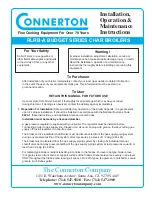
22
Xi. coNtrols aND accessories
The “Purge” indicator lamp (see
Figure #16
) will blink,
indicating a failure to prove adequate combustion air
flow or flue gas flow. The IBC will automatically reset
after 15 minutes or can be manually reset as noted in
the section titled
“Hot Surface Igniter.”
If the boiler can-
not be restored to normal operating condition by reset-
ting the control, contact a qualified service agency to
check the heat exchanger flue-ways for blockage.
loW WatER cut oFF
This unit is equipped with a low water cut off control
that protects against dry firing. This control provides
burner cut off if there is an unsafe water loss, which can
result from a broken or leaking radiator, pipe, or boiler.
A water/glycol mixture up to 50% concentration may be
used with the low water cut off.
EXtERnal condEnsatE puMp (optional)
For installations where there is no floor drain or other ap
-
propriate drainage available to receive condensate from
the boiler, an external float activated condensate pump
with integral sump (supplied by others) is required.
The condensate pump can be piped to a remote tie
in point to a sanitary sewer system. For this applica-
tion, the boiler must be installed so that proper pitch
of piping to the external condensate reservoir (sump)
can be accomplished. Use wood frame or blocks (not
factory supplied) to raise boiler as required for proper
installation.
Xii. startUP
WatER tREatMEnt and FREEZE pRotEctIon
1. Consult local water treatment specialist for recom-
mendations if your water pH levels are below of 7.0
or hardness is above 7 grains hardness.
a. This boiler is designed for use in a closed hy-
dronic heating system ONLY!
b. Excessive feeding of fresh make-up water to
the boiler may lead to premature failure of
the boiler sections.
2. Use clean fresh tap water for initial fill and periodic
make-up of boiler.
a. A sand filter must be used if fill and make-up
water from a well is to be used.
b. Consideration should be given to cleaning
the heating system, particularly in retrofit sit
-
uations where a new boiler is being installed
in an older piping system.
c. In older systems, obviously discolored, murky,
or dirty water, or a pH reading below 7, are in-
dications that the system should be cleaned.
d. A pH reading between 7 and 8 is preferred
when antifreeze is not used in the system.
3. Antifreeze, if needed, must be of a type specifically
designed for use in closed hydronic heating sys-
tems and be compatible with type 356 T6 alumi-
num at operating temperatures between 20°F and
250°F.
a. Use of antifreeze must be in accordance with
local plumbing codes.
b. Pure glycol solutions are very corrosive,
therefore hydronic system antifreeze typi-
cally contains corrosion inhibitors. Different
brands of hydronic system antifreeze contain
different types of corrosion inhibitors. Some
brands have corrosion inhibitors that break
down more rapidly or become ineffective at
higher temperatures when used with alumi-
num. This could lead to premature failure of
the aluminum boiler. Consult the antifreeze
manufacturer on the compatibility of their
product with aluminum.
c. Follow the antifreeze manufacturer’s instruc
-
tions on determining proper ratio of antifreeze
to water for the expected low temperature
conditions, and for maintaining the quality of
the antifreeze solution from year to year. Im-
properly maintained antifreeze solutions will
gradually lose their ability to protect the alu-
minum boiler from corrosion.
d.
the recommended premixed antifreeze
solution is iNtercool NFP-50.
This prod-
uct is sold direct to distributors by the manu-
facturer. Please contact Interstate Chemical
















































